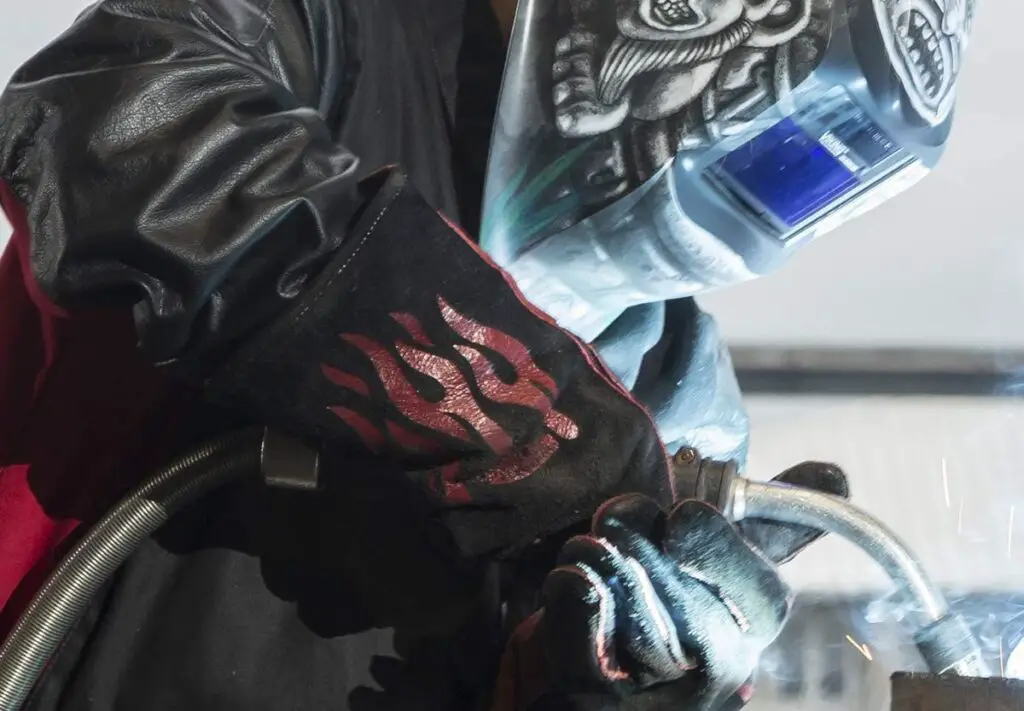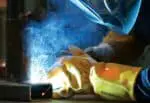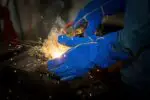Our hands are one of the most valuable yet also the most exposed parts. We rely on them for the most basic activities in our day to day life.
And whether you are conducting TIG, MIG, or stick welding, you should be aware that the welding process generates a lot of heat, which can result in welding burns if not handled properly. Therefore, a sturdy pair of welding gloves is required to avoid any injuries.
A good pair of welding gloves will provide protection against painful heat and burns. They should be flame-resistant so that they don’t catch fire while you’re working, and they should be comfortable enough that you may operate freely without your hands sweating.
Welding gloves are essential for preventing hand and elbow burns, as well as other types of occupational hazards that may occur during welding work.
So, what are the characteristics of a solid pair of welding gloves?
1.) Resistance to heat and heat protection: Whether you’re doing MIG, stick, or arc welding, the foremost thing you would look for in your welding glove is that it protects your hands from the heat generated during the welding process.
A good quality welding glove should not only be fire-resistant, but it should also keep your hands cool on the inside, allowing you to work comfortably.
2.) Toughness and reliability: A welding glove that cannot withstand cuts and punctures may cause more difficulties than it solves, especially if you overlook the cut and continue working with a damaged set of gloves.
3.) Moisture permeability: It is critical that the interior of a welding glove be composed of a moisture-absorbing lining so that you are comfortable while working. Sweaty hands are no doubt uncomfortable and they are dangerous too.
4.) Flexibility and dexterity: Welding gloves are no different than gardening gloves in terms of flexibility and dexterity.
They are essential for physical labor, and if you can’t move your hands flexibly inside, or if the gloves induce a lack of dexterity due to discomfort, your efficiency at work will be affected.
5.) Comfort: Your welding gloves should not feel uncomfortable while you wear them. For that, make certain that the gloves you pick fit properly. Welders frequently remove their gloves when they get uncomfortable, exposing them to preventable hazards.
6.) Proper fit: Even if you have one of the most solid gloves made of the most durable materials, you will still compromise on safety if it does not fit you properly.
The proper fit allows you to easily move your hands, wrist, and fingers and provides you with a greater range of motion.
See also: Do You Need Special Gloves For Welding?
What are the common materials used in the production of welding gloves?
The materials used in the production of welding gloves plays an important role in defining their features and uses.
1.) Leather
Leather welding gloves are maybe the most frequent form of welding glove material and there are a variety of leather that are often used. Let’s take a closer look:
2.) Cowhide: The most frequent type of leather used in welding gloves is cowhide. It is resistant to heat and fire while still providing the worker with considerable flexibility, dexterity, and comfort.
3.) Pigskin: Because pigskin is exceedingly durable, it is ideal for use in the production of welding gloves. It is, however, incredibly soft, so that you don’t have to compromise on comfort while wearing them.
4.) Elkskin: Elk skin creates highly pleasant and flexible gloves, and its softness does not budge against intense heat like cowhide does. However, it is quite thin, so it may be more prone to cuts and punctures.
5.) Deerskin: The major benefit of deerskin gloves is their elasticity and comfort. They are primarily intended for MIG welding. Overall, they are ideal for those long hours of labor.
6.) Goatskin: The flexibility, strength, and longevity makes these gloves ideal for TIG welding. They are grease and weather resistant, while also allowing for the flexibility needed to pick up and feed filler metal rods with ease.
7.) Cotton gloves
Cotton gloves that are lightweight and flexible are also available. Cotton is breathable, so it’s great for your skin. Welding gloves made of cotton provides both safety and comfort while you’re welding.
8.) Rubber gloves
Rubber gloves are well-known for their durability and tenacity. They protect against electric shocks and wetness while also offering an exceptional grip.
9.) Aluminized gloves
Aluminized welding gloves can help protect your hands from severe heat. Aluminized gloves are made of different materials, such as cowhide or elk skin, with a coating of aluminium on top that reflects heat radiation, keeping your hands cooler.
Also, the type of welding gloves depend greatly on the type of welding that is to be done. Let us help you understand this in detail-
MIG welding gloves
Although some welders utilise high-quality goatskin gloves with a heat-resistant liner for some MIG welding applications, the increased levels of heat and spatter produced during the MIG process make a thicker glove preferable for safety reasons.
Top-grain cowhide, goatskin, and deerskin are all frequent leather alternatives for MIG welding gloves.
A top-grain deerskin glove that adapts to your hand provides MIG welders with the protection and flexibility they require.
TIG welding gloves
Goatskin or any other equivalent thin, elastic material is ideal for most TIG applications. They offer great mobility for the exact welds produced by a TIG torch.
TIG gloves will not give as much protection for hotter operations that produce more spatter since the procedure produces less spatter.
Stick welding gloves
Stick welding is the most basic sort of welding since it does not include gases and does not need flexibility.
As a result, the thickness and protection from the heat and sparks that fly around from the fusion are the top priorities for stick welding gloves.
Because of this, the stick welding industry prefers pigskin or split-grain cowhide welding gloves. They are the most durable in terms of heat and abrasion resistance, as well as flame resistance.
Recommended welding gloves
1.) Lincoln Electric MIG/Stick Welding Gloves
- GREAT HEAT RESISTANCE
- INDUSTRIAL DURABILITY
- SUPERIOR COMFORT
- USED BY PROFESSIONALS
- Recommended for Stick welding (SMAW), Mig welding (GMAW), Flux-Core welding (FCAW) or other high temperature applications
Prices pulled from the Amazon Product Advertising API on:
Product prices and availability are accurate as of the date/time indicated and are subject to change. Any price and availability information displayed on [relevant Amazon Site(s), as applicable] at the time of purchase will apply to the purchase of this product.
These welding gloves, constructed of high-quality cowhide leather, is one of the most reliable welding glove.
The Kevlar stitching adds to its durability, while the soft cotton hand liner and thumb design provide the worker with much-needed comfort and sensitivity during high-heat labor.
2.) Caiman American Deerskin Welding Glove
- Designed for overhead welding, stick and plasma
- Industry first 21 inch glove with heavy duty padding
- Genuine American Deer split palm
- Boarhide leather heat shield patch, reinforced palm, cuff and lean on patch
- Sewn with Kevlar thread
Prices pulled from the Amazon Product Advertising API on:
Product prices and availability are accurate as of the date/time indicated and are subject to change. Any price and availability information displayed on [relevant Amazon Site(s), as applicable] at the time of purchase will apply to the purchase of this product.
These gloves with its deerskin split palm, 100% Kevlar threads, heavy-duty padding, and boarhide leather patch is one of the most robust, tenacious, and suitable gloves for stick welding.
These gloves perfectly fit the shape of a human hand, so that when you put them on, they adapt themselves to achieve optimal comfort and fit.
3.) RAPICCA Leather Forge Welding Gloves
- REINFORCED DOUBLE LAYER KEVLAER PADDING ON FINGER, PALM, ELBOW & BACK
- EXTREME FOUR LAYER HEAT RESISTANT PROTECTION
- SUPERIOR SECURITY FOR FORERAMS
- EXTREME WEAR RESISTANT PROTECTION
Prices pulled from the Amazon Product Advertising API on:
Product prices and availability are accurate as of the date/time indicated and are subject to change. Any price and availability information displayed on [relevant Amazon Site(s), as applicable] at the time of purchase will apply to the purchase of this product.
These welding gloves are some of the best stick welding gloves available, composed mostly of real cowhide split leather and insulated cotton for good protection and great comfort.
They are the only ones that provide a double-reinforced kevlar layer on every area of the gloves, making them heat-resistant.
Conclusion
Welding is a pretty tough job, and you need some special PPEs to protect yourself from the dangers of it.
There are a few things to consider before you set out to purchase welding gloves for yourself, such as stitching, size, fit, insulation, water/fire resistance and cost.
With all this in mind, we hope this article will help you in buying a solid pair of welding gloves.










